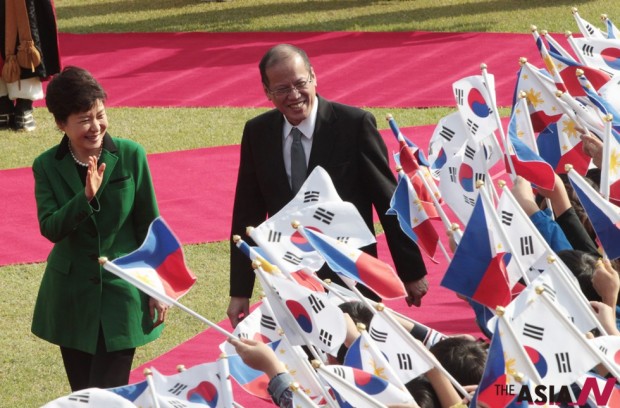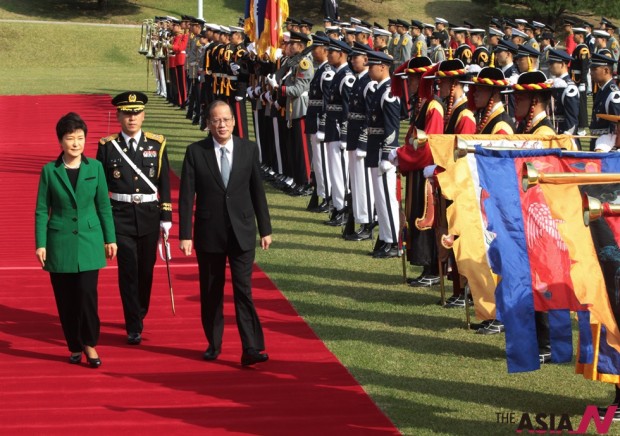Philippine President Aquino III visits S. Korea to discuss trade, investment

Philippine President Benigno Aquino III, right, and his South Korean counterpart Park Geun-hye greet children waving the two countries' national flags during a welcoming ceremony at the presidential house in Seoul, South Korea, Thursday, Oct. 17, 2013. (AP /NEWSis)
Philippine President Benigno Aquino III begins a two-day state visit to South Korea on Oct 17 to discuss trade, investment and defense cooperation.
It wasn’t clear on Wednesday whether the trip would even take place, as President Aquino rushed to the central Philippines to inspect heavy damage from Tuesday’s 7.2-magnitude earthquake. The earthquake, which had the power of 32 Hiroshima atomic bombs, left more than 100 people dead.
But Mr. Aquino decided to move ahead with the planned trip in which he will meet with South Korean President Park Geun-hye.
Roughly 1,000 Korean firms are in the Philippines, with Hanjin Shipping being the biggest with its $2 billion investment. Total trade between the two countries reached $7.37 billion in 2012, up 11% from $6.66 billion in 2011. South Korea enjoyed a trade surplus of $1.64 billion in 2012, narrower than the $2.18 billion posted in 2011.

Philippine President Benigno Aquino III, right, and his South Korean counterpart Park Geun-hye inspect an honor guard during a welcoming ceremony at the presidential house in Seoul, South Korea, Thursday, Oct. 17, 2013. (AP/NEWSis)
Meanwhile, South Koreans have become an important part of tourism in the Philippines, accounting for more than one-fifth of the 4.6 million foreign visitors last year. Filipinos have embraced South Korean culture, becoming fascinated by the country’s television soap operas and so-called K-pop, or Korean popular music.
South Korea this year also reduced the number of Filipinos that maybe allowed to work in the country due to increasing number of illegal workers. The Philippine Overseas Employment Administration had said that the quota was reduced to 4,200 this year from 5,200 in 2012.
The two countries have a military history together, stemming from the Philippines’ assistance during the Korean War.
The Philippines, a close ally of the U.S., was the first Asian country to send troops to South Korea in 1950 and kept a presence on the peninsula until 1955. More than 7,000 Filipino soldiers served in South Korea, including former President Fidel Ramos, under the United Nations Forces. Mr. Ramos was in South Korea last July, along with other Korean War veterans, to commemorate the 60th anniversary of the armistice that ended the war.
Mr. Aquino’s visit to South Korea will be a sentimental journey of sorts. His father, assassinated senator Benigno Aquino Jr., had his baptism of fire as a journalist in the Korean peninsula, reporting on the 1950-1953 Korean War as a 17-year-old correspondent for the Manila Times. The late senator received a presidential medal for his coverage, and his war coverage once was featured on the 500-peso bill.
As part of his itinerary, President Aquino will visit the War Memorial on Friday and receive recognition on behalf of his father for his coverage of the Korean War.
Ambassador Luis Cruz, the Philippines’ envoy to South Korea, told an ANC television interview that “Koreans treat us [Filipinos] as blood brothers because of the tremendous help that we have given to them, especially during the Korean War, and the rehabilitation of Korea immediately after the war.
























































